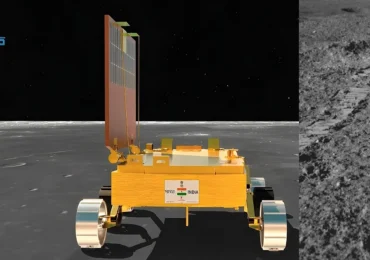
In a momentous achievement, India’s lunar rover has made its way onto the moon’s surface via a purpose-built ramp, announced Indian space officials on Thursday. The remarkable event took place mere hours after the country’s spacecraft made an historic landing near the moon’s south pole. This monumental achievement has triggered nationwide celebrations, underscoring India’s emergence as a pioneering force in the field of space exploration.
The state-operated Indian Space Research Organization (ISRO) reported that the Chandrayaan-3 Rover, having embarked on this historic journey, is poised to carry out a series of experiments over the span of 14 days. This includes an intricate analysis of the moon’s mineral composition, a task deemed crucial for advancing our understanding of lunar terrain.
The touchdown was met with jubilation across the nation as citizens congregated around televisions in workplaces, stores, and eateries on Wednesday. Spontaneous applause, dance, and the exchange of confections resonated through the airwaves as the perfectly executed landing was witnessed. Remarkably, the landing was orchestrated in an unexplored region that scientists believe could harbor substantial reserves of frozen water—an invaluable resource for future lunar expeditions.
Leading Indian dailies captured the essence of the moment with striking headlines. “India Goes Where No Nation’s Gone Before” proclaimed The Times of India, while the Indian Express joyfully exclaimed, “The Moon is Indian.”
Ajay Bhargava, an architect based in New Delhi, expressed his awe at the broadcasted landing, attributing the accomplishment to the dedicated efforts of India’s scientific community over time. In a resolute tone, he underscored that political credit should not eclipse the immense contributions of the nation’s scientists.
Indian Space Research Organization Chairman, S. Somnath, detailed the successful landing, indicating that it took place in close proximity to the center of the designated 4.5-kilometer-wide landing zone. The rover, now in motion, has been performing optimally, Somnath added.
The rover, equipped with two scientific instruments, is complemented by three instruments aboard the lander, all of which have been methodically activated. Their tasks encompass the comprehensive study of lunar mineral composition, atmospheric conditions, and seismic activities.
This accomplishment follows a previous unsuccessful attempt in 2019, placing India in the exclusive company of the United States, the Soviet Union, and China as the fourth nation to achieve this feat.
Beyond the realm of space, this successful mission amplifies India’s growing influence as a technological and space-centric powerhouse. Notably, it aligns with Prime Minister Narendra Modi’s vision of a resurgent nation solidifying its status among the global elite.
Initiated over a month ago at an estimated expenditure of $75 million, the mission’s triumph paves the way for India’s impending endeavor—a manned lunar mission. The strategically targeted lunar south pole region holds immense allure for numerous countries and private enterprises due to its shadowed craters that potentially house frozen water reserves. These reserves could serve as critical resources for future astronaut missions, enabling the production of drinking water and rocket fuel.
India’s victorious moment coincides with Russia’s recent setback as its Luna-25, also aimed at the same lunar region, spiraled into an uncontrolled orbit before crashing. This incident underscores the complexity of lunar missions and the required expertise.
India’s contributions to space exploration have been ongoing since the 1960s, involving satellite launches for both domestic and international purposes. A significant milestone was achieved in 2014 with the successful insertion of a satellite into Mars’ orbit. Looking ahead, India is slated to embark on its inaugural mission to the International Space Station in collaboration with the United States next year.
Disclaimer: The views, suggestions, and opinions expressed here are the sole responsibility of the experts. No Info Streamline journalist was involved in the writing and production of this article.





